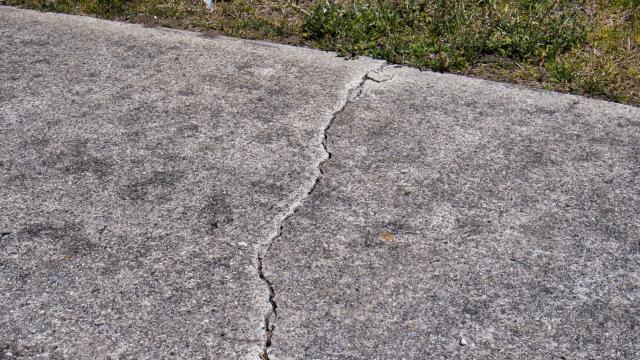After the winter months of rain, snow, ice, and frost, your driveway might not be looking its best — especially now that spring has sprung, and the weeds are further highlighting all its newly formed cracks. Repairing cracks in your driveway is important to keep them from getting larger, eventually requiring repaving or heavy maintenance. The good news is, you can take care of these smaller cracks yourself before they become a major problem down the road by following these steps.
You can patch cracks that are smaller than 2 inches yourself with a few tools and materials. Larger cracks will probably require a professional to fix. Remember that curing time will differ depending on the products you use, so you’ll need to plan ahead to park vehicles in a different location and keep kids and pets clear of the area for as long as necessary. This type of repair is more easily done when the weather is above 32 degrees and dry, but there are products you can get to deal with adverse weather conditions, too.
What you need to patch driveway cracks
To begin, you need to pick a patching compound. For concrete driveways, you can use a concrete patching compound. For blacktop driveways, you can use what’s known as a “cold patch” — either a non-heated patch material that needs to be mixed with water, or a premixed crack filler that goes straight into the cracks. “Hot patch” materials require professional equipment, so unless you plan to rent an oil-jacketed or direct-fire kettle, cold patch is your best bet.
You’ll also need:
- A sealer to keep your patch from washing out
- Sand for larger cracks
- A trowel or a small shovel
- A hose with a strong spray attachment (or a pressure washer)
- A tamper
- Cones, flags, caution tape, or sawhorses (to mark off the patched area)
Clean out the cracks
Once you’ve got your tools together, the next thing you need to do is remove all the weeds and dirt from the cracks to ensure the repair lasts longer. Hand-pull the weeds and using your hose or pressure washer attachment to clear out all debris. To make sure all the weeds are dead, you can apply horticultural vinegar, or burn or boil the weeds using hot water to make sure they can’t grow back.
Some people like to use commercial weed killer, but sticking with things like vinegar or heat will mean you’re not leaving anything poisonous around or washing those chemicals down the storm drain, so it’s generally a more animal- and kid-friendly approach.
Fill and smooth
The next step is to start filling cracks. Put some sand into any cracks that are more than about a half-inch deep. On concrete driveways, apply some patch compound to each crack with your trowel and smooth it out. Use care when mixing as the product can dry out quickly. Make sure not to apply more than you can smooth in the time it takes to harden or you’ll end up with a lumpy driveway.
For small cracks, the premixed crack filler is a great solution. Just make sure to follow all of the safety precautions on the label when applying because it can be harmful if inhaled or if it comes in contact with your skin. Use the trowel or small shovel to smooth it out.
For larger cracks, mix your cold patch with water and use your trowel at a 45-degree angle to push it into the crack, and then turn to 90 degrees to smooth the surface. Let the patches cure — generally, for a cold patch, this will only take a few minutes to an hour, but make sure to follow the directions.
Seal your patch
Once your patches are cured, you can apply your seal on top of the patches. Choose a sealant that is the same colour as your driveway; you can choose to only spot-seal or you can seal the whole surface, depending on how much of the driveway you are repairing. If you’re just spot-sealing, you can brush sealer onto the areas you patched. To seal the whole driveway, you’ll need an asphalt squeegee to spread the product, and a brush for the edges.
When you’re done, tape off the affected area with cones, sawhorses, and tape so that no one walks on your newly completed driveway while it’s still drying. Once the sealant is completely dry, your driveway will be ready to use.

Leave a Reply
You must be logged in to post a comment.